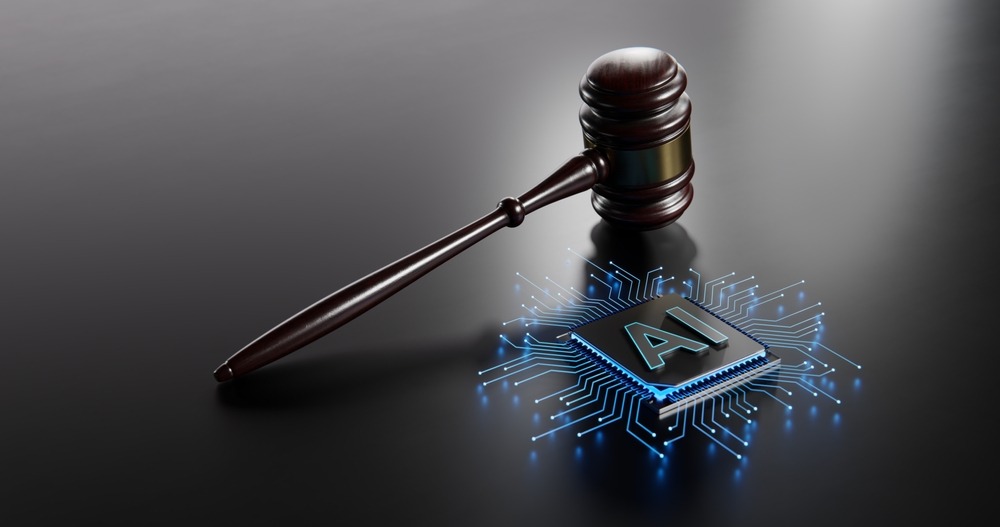Overcoming Challenges of AI in Law Firms

The rapid advancement of AI technologies presents law firms with unparalleled opportunities to enhance efficiency, improve strategic decision-making, and streamline operations. From automating routine tasks to uncovering insights through predictive analysis, AI is revolutionizing the legal profession. Yet, as firms embrace this transformation, it’s essential to address and mitigate the associated challenges to maximize its potential responsibly and ethically.
In this article, we’ll explore how law firms can leverage AI to their advantage while navigating key concerns such as data privacy, bias, and integration hurdles. Insights from U.S. Legal’s 2024 annual survey of 1,000+ legal leaders will guide our discussion on creating a balanced approach to adopting AI and overcoming potential challenges.
Securing AI-Driven Innovation: Addressing Data Privacy in Law Firms
AI in law firms offers unparalleled opportunities to analyze legal data, uncover insights, and enhance client service. However, as firms integrate AI, safeguarding privileged client information becomes critical. By adopting robust data privacy policies and security measures, law firms can confidently leverage AI’s power while mitigating risks.
Handling Sensitive Client Data
Introducing AI requires considering:
- How and when to strip client data before introducing it to AI tools
- How security controls will protect data within your AI systems
- Degree of AI interactivity, both internally and externally
Mitigating Risks of Data Breaches
In our survey, data privacy policies led the pack by a wide margin as the most important measures when vetting technology vendors and litigation support providers, noted by 70.86% of firms.
Working with vendors and support providers who utilize independent audits and have clear and thorough security and data privacy procedures is one way to mitigate the risk of a data breach. Other data privacy trends include:
- Adopting firm-wide advanced cybersecurity measures and tools
- Staying current on developing legislation and industry guidelines
- Prioritizing data protection training for employees
Ethical Implications of AI in Legal Practice
AI enables legal professionals to automate routine tasks, enhance accuracy, and uncover patterns in case outcomes. To ensure these benefits are realized ethically, firms must proactively address concerns around bias and transparency. Lawyers play a critical role in maintaining ethical standards while using AI tools.
Bias in AI Algorithms
Bias is a frontrunner for conversations on AI legal issues. AI isn’t created in a vacuum, and human biases—particularly when baked into research study design, historical precedent, and other large-scale sources of machine learning—can significantly affect outcomes.
Bias can come from good intentions gone wrong as well as input from more obviously prejudicial directions. Consider the launch of the Gemini 1.5 AI image generator in February 2024—Google quickly suppressed its ability to generate images of people after it consistently supplied images of women and men of color vs. white men even when historically inaccurate and utterly illogical (i.e., 1940’s German Nazis and the Founding Fathers).1
Attorneys and firms need to be particularly cognizant of bias for2:
- Original data sets and what biases may be baked into them
- Legal areas that rely on standards vs. strong rules
- Predictive models of case outcomes
- Systems without full transparency of input and algorithmic and analytical models
This quote from a post on Bias and Ethics in AI-Enabled Legal Technology from the Yale Journal of Law & Technology says it well: “… lawyers must preserve their critical role in engaging with results produced by technology tools, to test for accuracy, truth and the threat of bias.”3
Compliance with Legal and Ethical Standards
Adhering to legal and ethical standards isn’t new to law firms, but adding or more deeply integrating AI tools requires another layer of compliance requirements and ethical considerations. These include4:
- Transparency with clients on how AI is employed on their behalf
- Traceability of how AI input influences law firm decisions and recommendations
- How AI is either directly or indirectly included in your state and professional rules
Overlooking these considerations can cause key legal issues for firms leveraging any AI model.
AI Integration with Legacy Systems
Like any jump in technology, introducing AI doesn’t mean throwing out effective systems already in place. Just as AI is best used as a partner to human intelligence, AI systems are best partnered as connected tools that speak to other data sources and layers of your tech stack.
Compatibility Requirements
Interconnectivity across platforms and systems with key data and files is ideal but not always simple. Any time firms introduce a new tech component, they must also ensure:
- Systems are compatible
- Users can be trained to understand how the systems connect
- IT support is available that encompasses connection and compatibility
Costs of System Upgrades
Technology investments come with costs. Before you secure funds, make sure you’re comparing the total costs of competing products that include:
- Required upgrades to current systems
- Replacements to current systems
- The cost of time, training, and onboarding
Lack of AI Expertise Among Legal Professionals
One of the biggest challenges for integrating AI into the legal workplace is the learning curve for attorneys and support staff. It takes more than the push of a button to get the results you need.
The maxim “garbage in, garbage out” is especially true for AI tools. Since machine learning is interactive and growing, ensuring that your team knows what they’re doing impacts both immediate results and performance over time.
A key benefit of the use of AI is its ability to adapt at a firm-specific level, such as:
- Refining specialized practice area knowledge
- Use of specific cases and argument models
- Tone and branding language
Training and Knowledge Gaps
Unlike many consumer devices and even many business products, using AI isn’t a simple, intuitive user jump. Training is required to understand both the concepts behind how the systems work and the exact steps to get the results that you need from the specific software.
More than a third of our survey respondents identified limited training and human error as top challenges encountered while integrating AI into their legal practice.
Over-Reliance on AI for Decision-Making
AI isn’t a replacement for individual decision-making or professional expertise. Its ideal use is as a supporting player under live human knowledge and input. Human oversight and established procedures around traceability and transparency are necessary to avoid a creep toward overreliance.
AI Adoption and Resistance to Change
Beyond the need for training, some attorneys remain reluctant to adopt and adapt to AI. Understanding and addressing these reservations as part of an onboarding process communicated by law firm leaders can reduce resistance and speed adaptation.
Concerns Over Job Replacement
If AI can learn anything, can it replace my job? Job replacement or reduction remain common concerns about AI—and, in some roles and industries, these concerns hold merit.
To better understand how firms are currently using AI, here’s a breakdown from our survey:
- Legal research – 20%
- Document management and automation – 13.77%
- Contract and document review – 10.58%
- Transcript or record summarization – 11.01%
- Predictive analysis – 9.86%
- Automation of routine tasks – 9.13%
- Litigation analysis – 8.55%
- Virtual assistant – 6.52%
- Data analysis – 5.36%
- Business intelligence – 4.78%
Leadership being transparent about the intended uses of AI and how they’re likely to benefit staff (i.e., freeing up paralegals to concentrate on higher-skill vs. rote tasks) will go a long way.
Skepticism Towards AI Capabilities
On the other end of the spectrum, some may simply doubt that AI tools can be trusted to do what’s requested with thoroughness and accuracy. A skeptical voice isn’t always a negative—there have been incidents of AI making up cases in entirely fictional citations (i.e., “hallucinations”), and there’s a reason that AI use needs to be paired with human oversight.5
Consider enlisting skeptical voices into discussions around oversight, transparency, and traceability of AI use, along with exposure and training on AI principles along with firm-selected tools.
AI in Law Firms: Overcoming the Challenges
The number of survey respondents who identified AI and machine learning among their firm’s highest-priority tech initiatives for the upcoming year grew 48.5% from our 2023 to 2024 survey. Still, only 18.96% of firms report having conducted any AI training.
The knowledge gap is perhaps the top slow-down to AI’s integration throughout the legal industry. More than simple software training, firm leaders need to understand:
- The concepts behind AI and machine learning
- How AI integration can increase efficiency, improve results, and lower costs
- The importance of partnering with legal service providers who lead the way
U.S. Legal Support combines our nearly 30 years as a provider of best-in-class, nationwide litigation support services with the prioritization of growth and progress, including integrating technology such as AI to better serve our clients. Our security management includes end-to-end file encryption, compliance with HIPAA, SOC 2 Type 2, and the NIST Cybersecurity Framework, plus redundant data centers and a 24/7 network and security operations center.
We offer court reporting, transcription, interpreting, record retrieval and analysis, and trial services—from TrialQuest —including trial and jury research and consulting, mock trials, witness preparation, trial graphics and demonstratives, and trial presentation and technology services.
Ready to learn more? Reach out today to connect with us on your legal support needs.
Sources:
- The Verge. Google pauses Gemini’s ability to generate AI images of people after diversity errors / The company’s attempts to subvert racial and gender stereotypes created new problems. https://www.theverge.com/2024/2/22/24079876/google-gemini-ai-photos-people-pause
- Forbes. Artificial Intelligence (AI) And The Law: Helping Lawyers While Avoiding Biased Algorithms. https://www.forbes.com/sites/davidteich/2020/02/18/artificial-intelligence-ai-and-the-law-helping-lawyers-while-avoiding-biased-algorithms/
- Yale Journal of Law & Technology. Bias and Ethics in AI-Enabled Legal Technology: Examining the Role and Impact of Human Inputs on AI-Rendered Results in Legal Matters. https://yjolt.org/blog/bias-and-ethics-ai-enabled-legal-technology-examining-role-and-impact-human-inputs-ai-rendered
- Cimplifi. ABA Guidance on the Use of AI. https://www.cimplifi.com/resources/aba-guidance-on-the-use-of-ai/
- American Enterprise Institute. When Generative AI Fabricates Cases That Attorneys Cite, Sanctions Follow. https://www.aei.org/technology-and-innovation/when-generative-ai-fabricates-cases-that-attorneys-cite-sanctions-follow/

Editoral Policy
Content published on the U.S. Legal Support blog is reviewed by professionals in the legal and litigation support services field to help ensure accurate information. The information provided in this blog is for informational purposes only and should not be construed as legal advice for attorneys or clients.

